Royalty Flush
A noted solutions architect offers an audacious plan for AI acceptance. It just might work.
The talk of AI-based printed circuit design – and the idea that artificial intelligence could theoretically design a board faster and more efficiently than a human – has inevitably led to the fear that designers will be replaced by their algorithmic counterparts.
Rather than stoke those fears, a proposed process for AI implementation presented by a leading ECAD architect at PCB West in October focused on the new opportunities that could come for designers as AI implementation begins to take place.
That proposal, offered up in the keynote address by Charles Pfeil, was the precursor to several panels and conference sessions at this year’s conference, apropos as AI and its impact on PCB designers is front and center on the minds of many in the industry as AI continues to grow.

Figure 1. Charles Pfeil discusses a roadmap for AI in PCB design during his keynote address at PCB West.
The annual return of PCB West, the largest conference and exhibition for printed circuit board design, fabrication and assembly in Silicon Valley, saw attendees with a renewed air of excitement and energy – marked by the expo’s highest attendance since before the Covid-19 pandemic and four days of packed sessions taught by many of the industry’s leading minds.
In addition to the more than 125 hours of conference presentations and panels covering topics from signal integrity and DfM to thermal and rigid-flex design were several timely sessions on AI in electronics.
Pay to Play
Before AI can take a leading role in the design process, however, the artificial designers still need lots of training – with current autorouting and autoplacement programs serving as an example of the work that needs to be done.
Many designers say it takes more time to go back and fix those programs’ mistakes than just doing the job themselves, especially when dealing with complicated boards that have multiple factors to consider, Pfeil said.
“The AI needs to learn how to balance multiple competing objectives and make effective tradeoffs,” he said. “This is what the designer does.”
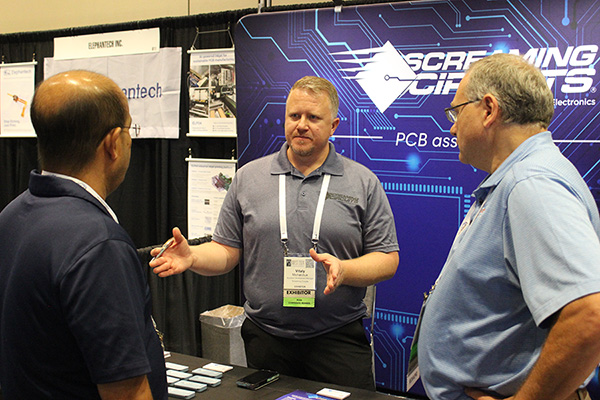
Figure 2. Screaming Circuits business development manager Vitaly Michalchuk explains the EMS company's service offerings.
For the AI models to improve their design capabilities, EDA companies will need access to known-good designs for training, but getting those designs could prove challenging as many companies are hesitant to give up their IP, he said.
To solve that problem, EDA companies will likely need to develop compensation plans to convince customers to give up their copyrighted materials for training, but getting access to those designs is only the first piece of the puzzle.
Simply adding designs into a database will not fully train an AI to design a board, as there are multiple methods to solve design problems, with some methods working in certain situations but not others, Pfeil noted.
He said training AI to know what methods to use and when to use them will require expert designers to put their thought processes on paper through the development of decision trees that the AI can follow to determine what to prioritize at each step of the design process.
Like the method for encouraging companies to use their design for training, Pfeil proposed a similar compensation track for designers, who may feel alienated or like they’re being pushed out of the industry by the continued advances in AI design.
He said that rather than telling designers that AI will replace them, employers should encourage their teams to take an active role in developing the AI models.
To incentivize them to do so, those companies could create new positions for designers and put them in charge of training AI models or offer royalties to designers whose designs and concepts are used for training and later used in new AI-generated designs.
Looking to the future, as AI takes a more leading role in the design process, today’s designers could have long-term opportunities to oversee or improve AI learning at their current employer or EDA companies, or they could transition into AI-assisted design consultants or managers, Pfeil said.
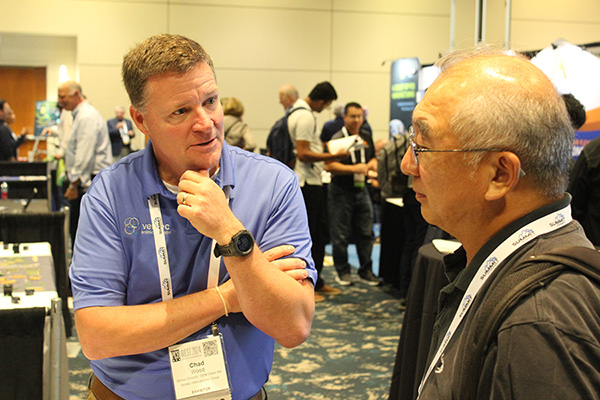
Figure 3. Ventec’s Chad Wood (left) speaks to a PCB West exhibition attendee.
To encourage that transition, companies would need to offer new compensation packages that reflect the long-term savings that would come from the advances in AI-based design, he said.
“I believe designers who help train AI should be substantially compensated,” he said. “Because what they’re doing for that company is creating an environment where they can get their boards faster and more effectively.”
‘Eager to Learn’
For PCB West’s one-day exhibition, the floor was the liveliest it has been in years, with registration and attendance rising to their highest numbers since 2019 – before the Covid-19 pandemic threw a wrench into the works of live events.
The energy of exhibition attendees was reciprocated by the more than 100 exhibiting companies and the staff members staffing their booths.
“This has been a great turnout,” said Jill Oxnam, product manager at Screaming Circuits.
The Oregon-based electronics manufacturer is a regular exhibitor at both PCB West and PCB East, and this year’s show provided some good conversations and some excellent leads, she said.
Summit Interconnect senior account manager Allison Herrera shared the same sentiment, saying the show provides an opportunity for face-to-face time with both those they know and those they would like to meet.
“We’ve had a lot of visits from existing customers and some potential new customers,” she said. “We’ve seen a lot of industry friends, and we’ve had a lot of activity from people wanting to know about what we offer.”
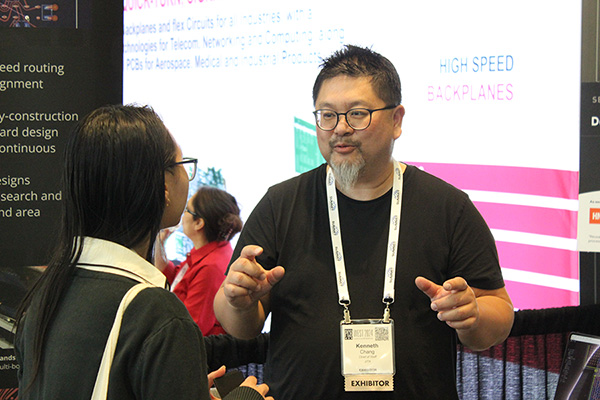
Figure 4. JITX chief of staff Kenneth Chang applauded the mix of designers and engineers.
The PCB manufacturer is another regular PCB West exhibitor, with this year marking the eighth time that Herrera had personally been to the show, and she said the 2024 crowd was the best she had seen in recent years.
“Post-Covid, this is the best show I’ve seen,” she said.
Mike Peterseim, representing Canadian PCB manufacturer PFC Flexible Circuits, said he had some great conversations throughout the day, and he thought this year’s attendees were more engaged when they were visiting booths.
“I think this is one of the better years,” he said. “I feel like the people walking the show are more project-specific and actually have projects they’re working on and not just looking for contacts,” he said.
For KiCad, the provider of open-source design software, this year marked the first time the company was represented as an exhibitor, but project lead Seth Hillbrand said he was pleasantly surprised at the growth he saw.
“It’s a fantastic show,” he said. “I haven’t been to PCB West in about a decade, and it’s nice to see how it’s grown.”
Hillbrand said the crowd featured a good mix of attendees, including designers and businesses looking for more information, and the show permitted the company to share some of its lesser-known offerings directly with those businesses.
“We haven’t done trade shows before, but we were getting a lot of people saying they didn’t know we offered business services,” he said. “We figured that it would probably be a good idea to go to where we can interact with the businesses and get the message out there.”
For first-time exhibitor Founder PCB, a Chinese PCB manufacturer that has expanded with a new US sales team, PCB West was better than anticipated, with representatives from some of the bigger Silicon Valley companies stopping by their booth for a chat, said director of North American sales Marvin Gaines.
“It’s a better turnout than I expected, both in the number of people and the quality of the crowd,” he said.
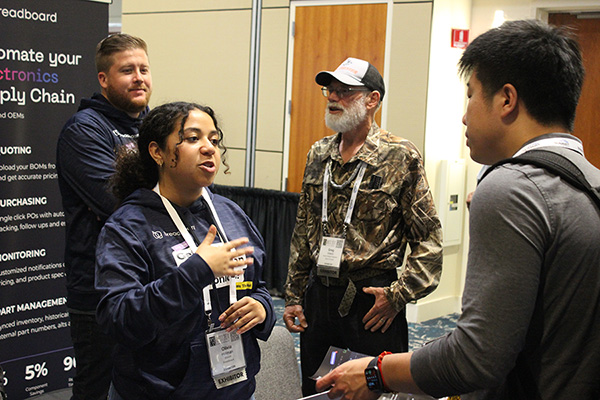
Figure 5. Breadboard’s Olivia Holman speaks with a PCB West visitor.
While this year’s crowd grew in number, it also brought in some of the younger demographic, which is a good sign for an industry that is seeing many workers entering retirement age, said Igor Luvishis, president of Elgris Technologies, a provider of translators to exchange data among EDA platforms.
“I can tell you that at this show, there are more people,” he said. “And I can tell you there are younger people, which is good news.”
PCB West also offers an opportunity for smaller or lesser-known companies to represent themselves and make new connections, said Tony Torres of Israeli fabricator and assembler PCB Technologies.
“I think it’s been very, very successful,” he said. “We’ve had a lot of people coming through and I’m sure we’re going to do it again next year.”
Canadian electronics manufacturer Trilogy-Net is another regular exhibitor, but it was the first time in a few years for president Trevor Pullishy, who pointed out that the show is seeing new companies and new attendees as more aspects of the industry are represented.
“It’s been three years since I attended, and the crowd’s definitely changed in those three years,” he said. “There’s a lot more diversification.”
Another of the newer companies in attendance, JITX, a startup developing a method for code-based PCB design, saw big crowds at its booth throughout the day and hosted a design community meetup and generative AI panel to encourage more networking after the show.
Chief of staff Kenneth Chang seconded the diversity of the audience and said companies like Cofactr operating in the GenAI space may have drawn non-typical PCB designers as supply chain management takes a more central role in the industry.
He also pointed out that despite the size of the event, PCB West still provides an intimate experience for exhibitors and attendees to get to know each other.
“Quality engagement with customers and vendors was nonstop from the get-go,” he said.
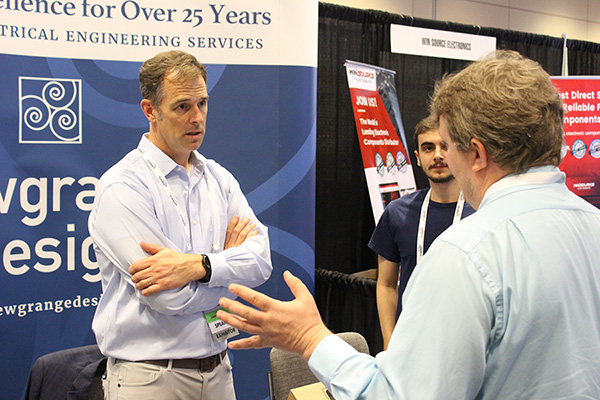
Figure 6. Newgrange Design president Matthew Leary (left) speaks to an attendee of PCB West.
With AI a hot topic among the conference sessions and panels, a few AI-focused companies also exhibited at the show, including Cofactr, a specialist in supply chain management that uses AI to enhance its component selection and procurement software.
“This year felt like a room eager to learn and explore,” said chief strategy officer and cofounder Phil Gulley, who also participated in the PCEA-JITX GenAI panel. “It’s inspiring to see startups, innovative organizations, leading manufacturers, established enterprises and everything in between sharing ideas and digging into the topics we're all passionate about.”
is managing editor of PCDF/CIRCUITS ASSEMBLY;This email address is being protected from spambots. You need JavaScript enabled to view it..




